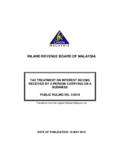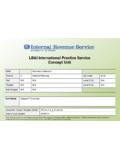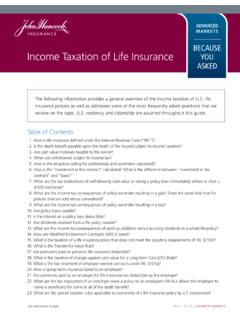Transcription of LB&I International Practice Service Transaction Unit
1 LB&I International Practice Service Transaction unit IPS Level Number Title UIL Code Number Shelf N/A Business Outbound Volume 2 Deferral Planning Level 1 UIL 9412 Part Foreign Personal Holding Company Issues Level 2 UIL Chapter interest , Dividends or other FPHCI Level 3 UIL Sub-Chapter Exceptions from FPHCI re: payor unit Name Receipt of Dividends or interest from a Related CFC Document Control Number (DCN) (2016) Date of Last Update 01/05/2016 Note: This document is not an official pronouncement of law, and cannot be used, cited or relied upon as such.
2 Further, this document may not contain a comprehensive discussion of all pertinent issues or law or the IRS's interpretation of current law. Table of Contents (View this PowerPoint in Presentation View to click on the links below) General Overview 2 Issue and Transaction Overview Transaction and Fact Pattern Effective Tax Rate Overview Summary of Potential Issues Audit Steps Training and Additional Resources Glossary of Terms and Acronyms Index of Related Issues Issue and Transaction Overview Receipt of Dividends or interest from a Related
3 CFC Generally, the US shareholder of a foreign corporation is able to defer taxation of the corporation s income until it has been distributed to the shareholder. However, in the case of a controlled foreign corporation ( CFC ), certain types of income are subject to current inclusion ( subpart F inclusion ) by the US shareholder under IRC 951. One such type of income is Foreign Personal Holding Company income (FPHCI), which includes income of a CFC such as dividends, interest , rents, and royalties. The FPHCI rules eliminate the deferral of US tax on income earned by certain foreign corporations from portfolio types of investments, , where the company is merely passively receiving investment income rather than earning active business income .
4 Consequently, many of the exceptions to current inclusion of FPHCI focus on the recipients of income ( , whether the recipients meet certain criteria). However, in the case of certain related party transactions , the exceptions from FPHCI focus on the payor of the income rather than the recipient. For example, under the FPHCI look-thru rule (not to be confused with the foreign tax credit ( FTC ) look-thru rules, which are beyond the scope of this unit ), FPHCI does not include dividends, interest , rents, and royalties if such income is received or accrued from a related CFC and the income is not attributable to subpart F income or income effectively connected with a US trade or business ( ECI ) of the related CFC.
5 The look-thru rule is found in IRC 954(c)(6), and is often referred to as the 954(c)(6) exception , or simply (c)(6) . This exception allows US shareholders to reinvest active foreign earnings of one CFC in a related CFC without current taxation, as long as the underlying income of the payor CFC would not otherwise have been subject to current US taxation ( , as subpart F income or ECI). Note, however, that the exception is not elective; if the requirements are met, the income is not FPHCI. Another exception that looks to the payor of the income for eligibility requirements is the same country exception from FPHCI under IRC 954(c)(3).
6 Under the same country exception, FPHCI does not include dividends and interest received by a CFC from a related CFC payor which is incorporated in the same country as the recipient CFC, and which has a substantial part of its assets used in its trade or business in that same country. Similarly, under this exception, FPHCI does not include rents and royalties received by a CFC from a related CFC for the use or privilege of using property within the same country as the recipient CFC s country of incorporation. However, the FPHCI implications/treatment of rents/royalties are outside the scope of this unit and will be covered in a separate unit .
7 3 Back to Table Of Contents Issue and Transaction Overview (cont d) Receipt of Dividends or interest from a Related CFC The same country exception was originally enacted in 1962 as a part of the broader subpart F legislation. The Kennedy administration and Congress were concerned with tax haven deferral the shifting of income earned in one country to a tax haven jurisdiction.
8 Because payments between related parties located in the same country don t shift income to another jurisdiction, such same-country payments were excluded from the definition of FPHCI. However, before 2006, when the look-thru rules were first enacted, FPHCI still included payments from a CFC in one country to a related CFC in another, even if the income was from an active business. In proposing the look-thru rules, the House Ways and Means Committee said, Most countries allow their companies to redeploy active foreign earnings with no additional tax burden.
9 The Committee believes that this provision will make US companies and US workers more competitive with respect to such countries. By allowing US companies to reinvest their active foreign earnings where they are most needed without incurring the immediate additional tax that companies based in many other countries never incur, the Committee believes that the provision will enable US companies to make more sales overseas, and thus produce more goods in the United States (HR Rep. No. 304, 109th Cong., 1st Sess. 45 (2005)). The look-thru rule was first effective for tax years of CFCs beginning after December 31, 2005, and before January 1, 2009.
10 It has since been extended on multiple occasions, and is currently effective for tax years of CFCs beginning before January 1, 2020. No regulations have been issued to date on the look-thru rule; however, guidance was issued in Notice 2007-9. Consequently, it will be critical for the examiner to review Notice 2007-9 in connection with this issue. This unit covers in detail the same country exception and look-thru rules for FPHCI (specifically dividends and interest ). It includes a scenario with both an interest and dividend payment, and the issues covered in the unit compare the treatment of the payments under both the look-thru rule and the same country exception from FPHCI.
















